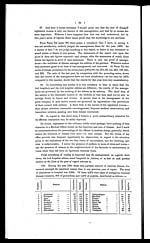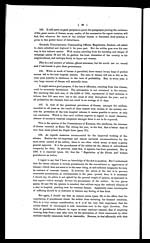Medicine - Institutions > Lock hospitals > Annual report on the working of the lock hospitals in the North-Western Provinces and Oudh > Eighth annual report of the working of the lock hospitals in the North-Western Provinces and Oudh, for the year 1881
(295) Page 25
Download files
Individual page:
Thumbnail gallery: Grid view | List view

( 25 )
In all stations, the ratio of contagious disease prevalence amongst the registered
women was high. I select a few for special record:-
| Station. | Monthly average of women. |
Cases of contagious disease. |
Ratio per cent. |
| Allahabad | 137 | 334 | 295.5 |
| Cawnpore | 108 | 203 | 178.7 |
| Meerut | 94 | 249 | 264.8 |
| Benares | 56 | 125 | 223.2 |
| Moradabad | 67 | 168 | 250.7 |
| Sháhjahánpur | 42 | 135 | 321.4 |
| Roorkee | 34 | 132 | 388.2 |
| Chakráta | 19 | 53 | 289.4 |
101. In every year, this serious prevalence of disease, amongst the registered
women, is seen to prevail. And I bring the fact more prominently to notice, this year,
to illustrate the extraordinary disease perils of this class of women, and to empha-
size the necessity of frequent examination, as the only safe means of disease preven-
tion. Para. 20 contains an influential opinion, favouring the less frequent examina-
tion of the women, as a means of encouragement to registration. Para. 3 records an
opinion, favouring the more frequent examination of the women by matrons, as a
means of disease prevention. Of these conflicting opinions, I can only say, expe-
rience supports that last expressed. Managed as the scheme now is—the registered
women usually open to the advances of men of the general public, the soldiers open
to the advances of the women of the country—it is evident that the registered women
must be exposed to the extremest perils of promiscuous intercourse. The figures of
the women's disease record—equalling one fifth on their number always in hospital—
suffice to show the reality of the peril, against which only frequent examination can
provide any measure of remedy.
This discovery and cure of disease amongst the women, who by habit and office
are forced to be its chief distributors, is the one feature of the scheme which justifies
the expenditure entailed—the sole circumstance which has ever brought me, as
Sanitary Commissioner, any satisfaction in the preparation of these reports.
102. I suppose, as a matter of common sense, that some portion of the soldiers'
disease, in every station, must have been contracted from the registered women.
In many stations the soldiers assert the truth of this; but, as a rule, the medical exa-
mination of the accused women disproves the accusation.
The reports contain many statements to this effect. But at Agra (para. 13) it is
allowed that in eight cases there were grounds for the charge; at Meerut (para. 18) in
22 cases, and at Roorkee (para. 64) in two cases.
103. The registered women have, as a rule, behaved well, have been regular
in their attendance for examination, and patient under treatment. A total number
of 993 cases of absence from examination have been reported. The chief offenders in
this respect were the Agra city women, and the Fatehgarh, cantonment women. As
usual, this apparently serious total of absent women includes many instances of one
woman frequently reported, and of women unable to attend from sickness or other
unavoidable cause. From Roorkee it is reported (para. 61) that two women were
punished for leaving the hospital without permission.
104. Amongst the soldiers there were 3,340 cases of venereal disease, divisible
into 1,588 of gonorrhœa and 1,752 of syphilis. Allowing that some portion of this
disease was contracted from the registered women—an unavoidable circumstance under
the existing method of management—it cannot be doubtful, that its chief source was
intercourse with unregistered women, met by the soldiers in cantonments, in cities,
towns and villages, in camp, and upon the march. Almost from every station, and
almost by every reporting authority, the truth of this is consented to. In some
instances, soldiers have confessed to having contracted disease from unregistered
women. Some of these unregistered offenders have been arrested, and, upon examina-
tion, frequently found diseased.
7
Set display mode to: Large image | Zoom image | Transcription
Images and transcriptions on this page, including medium image downloads, may be used under the Creative Commons Attribution 4.0 International Licence unless otherwise stated. ![]()
| Permanent URL | https://digital.nls.uk/75111756 |
|---|




